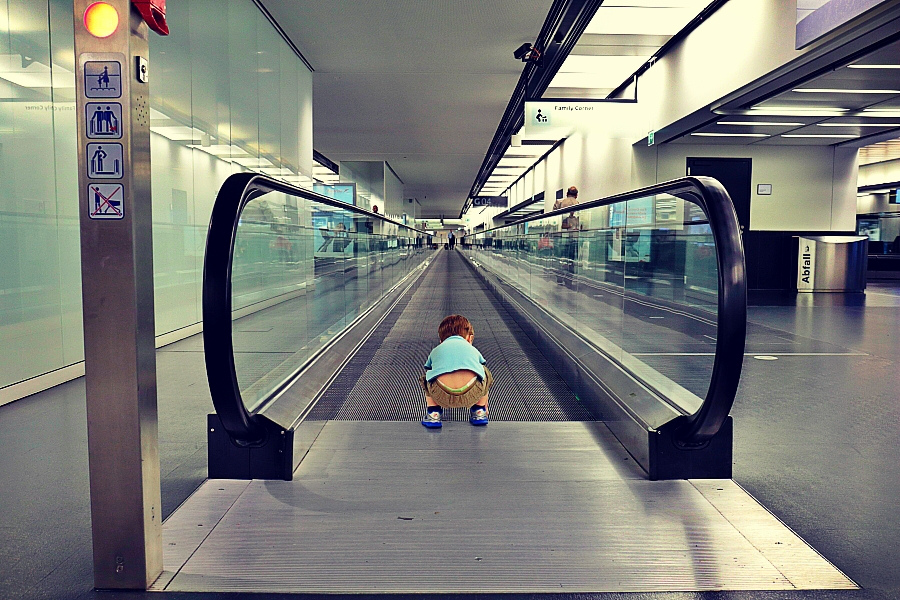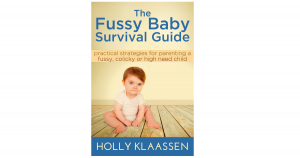- You are here:
- Home »
- Blog »
- High Need Babies »
- 7 Tips For Flying With A Fussy Baby
7 Tips For Flying With A Fussy Baby

Taking a high need baby or toddler on an airplane can be an utterly overwhelming prospect.
High need kids tend to have intense emotional needs that require constant attention. They cry more and often need non-stop entertainment.
The thought of taking them into a small space, surrounded by potentially judgmental strangers is scary! Your first thought may be to ditch the airplane ride and figure out another route. But, there are some circumstances where air travel simply can’t be avoided.
Take a deep breath and remember that most strangers are understanding when it comes to small children. Even if they’ve never encountered a high need baby before, if they see that you’re trying to soothe your child, they’ll most likely be sympathetic.
Even with that in mind, the prospect of flying can be frightening.
Here are a few ideas to help you navigate your next flight!
1. Choose the right flight.
Having a high need baby and a delayed flight is a recipe for disaster. Choosing an earlier flight can help reduce the chances of a delay. Weather could always cause flights to be behind schedule but the ripple effect of previous flight delays is minimized for early trips.
Remember though, you know your child. If your baby is harder to handle in the mornings, take a later flight. If you know she won’t nap when out in public, book your flight so you can leave immediately following nap time.
Try to choose a fight with minimal layovers and connections. Trying to find your next gate while also managing your baby could heighten your chance of missing the plane.
Keep things as simple as you can!
2. Choose your seat ahead of time.
Most airlines allow you to choose your seats when you book your tickets online. SeatGuru.com is a website that will allow you to look at your plane’s layout and will offer reviews of the seats. It also lists the airline’s amenities and any other airline-specific information.
Bulkhead seats (seats directly behind a wall or partition) are a good choice for parents of small children. There are no seats in front of you, and they tend to have more legroom than the exit row seats.
That means, if you have a toddler, they won’t accidentally kick a stranger’s seat, because there won’t be any. And, they will have a little room to play and stretch when the seatbelt signs are off.
If your child is still a baby, the bulkhead row is still a good choice because most airlines offer a bassinet option for these seats only. There are only a limited number of bassinets on each flight so make sure to book early to secure one. There should be an option to request one when booking but it’s always a good idea to call the airline to be sure your request went through.
You may also want to request an aisle seat, especially if you’re taking a longer flight. This will ensure you can get in and out of your seat easily for diaper changes or to grab anything out of the overhead storage area.
If you do end up choosing a window seat, stash some decals in your bag for your baby to play with…these window stickers go on and off easily and will keep your little one entertained for at least a few minutes!
3. Board last and have your documents ready.
If you’re travelling with a partner, have him or her board ahead of you and your child. They can get the carry-on luggage put away and install the car seat (if you choose to use one), or have the flight attendants install the bassinet, if needed. This way, you can hang back with your kid and let them get out a few more minutes of freedom before you confine them to a small spot.
If you’ll be holding your baby on your lap for the plane ride, make sure you have their birth certificate ready. Most airlines allow children, up to two-years-old, to sit on your lap, but some will request documentation.
Keep all boarding passes and any other important documents in an easily accessible spot for quick access.
4. Pack snacks and drinks.
It’s good to review the FAA’s guidelines for food and drink before traveling. According to their website, you can bring no more than 3.4 ounces of juice, water, baby food and formula to help soothe your child.
Having special snacks and drinks on hand is not only good for quenching hunger but it’s also a good distraction and can aid in relieving the effects of the cabin’s air pressure.
I recommend stashing some lollipops in your carry on. They’re a great aid for popping a toddler’s ears!
5. Pack some new toys.
New toys are a great distraction and the dollar store can be a great place to get a few fun toys without breaking the bank. You can pick out some things that you think will entertain your child, put them in a bag, and pull out a new one every twenty minutes or so (don’t make the mistake of handing the entire bag over at once!).
At 10 and almost-13, my kids STILL expect a bag of goodies when we travel. I usually set a budget of $20 and head out to the dollar store the night before a trip to load up on tic tacs, travel games, coloring/exercise books, and anything else I think will keep them occupied.
6. Bring a cell phone or laptop for games and videos.
Movies and games can help make sitting still for a few hours easier to handle.
Downloading media straight on to a laptop will probably be the easiest option for watching movies.
And, since your phone will be on airplane mode, you can hand it over to your baby without having to worry about him dialing your boss.
Keep in mind that some airlines require headphones while listening to music or watching movies, out of respect for those sitting next to you. Make sure your baby is okay with headphones before popping that movie on.
7. Make ice-breaker bags to hand out to the people around you.
If the idea of your baby upsetting those around you is stressing you out, you could put together little bags of goodies for the people who will be sitting by you.
A couple pieces of candy along with some cheap earplugs and a nice note should be enough to let people know that you are a proactive parent who is doing their best.
My final word of advice: Don’t forget to breathe.
Flying with babies is hard; high need babies can take that to a new altitude.
Adjust your expectations and be prepared for anything. If things get too stressful, do your best to take a moment to catch a few deep breaths and collect yourself.
The people around you are strangers, and although you don’t want to make anyone angry, there are some things you just can’t control.
Remember that this is a few hours in your life, and you’ll get through it.
 If you’re looking for more answers and guidance regarding your high need or fussy child, you might be interested in my new ebook, The Fussy Baby Survival Guide. It’s jam-packed with information, strategies, stories and the full results of two surveys I’ve done of parents of high need babies. It answers questions like:
If you’re looking for more answers and guidance regarding your high need or fussy child, you might be interested in my new ebook, The Fussy Baby Survival Guide. It’s jam-packed with information, strategies, stories and the full results of two surveys I’ve done of parents of high need babies. It answers questions like:
· How do I know if my baby is colicky, high need, or something else entirely?
· Will my high need baby ever get easier? And if so, WHEN?
· Is “high need” a real thing? Is there any research to back it up?
· What are the most effective strategies for helping my high need baby sleep?
· How do I deal with my child’s INTENSE tantrums?
For more info or to grab your copy now, click here!
photo credit: Roberto.Trombetta wien airport via photopin (license)
Other Posts You May Like
Best Products for Fussy Babies
50+ Best Toys & Products for Spirited Kids, 0-5: Christmas Gift Guide
Dealing with Defiance in Your Spirited Toddler or Preschooler
The Fussy Baby Site Goes to Facebook HQ!
How to Raise a Dragon Baby
